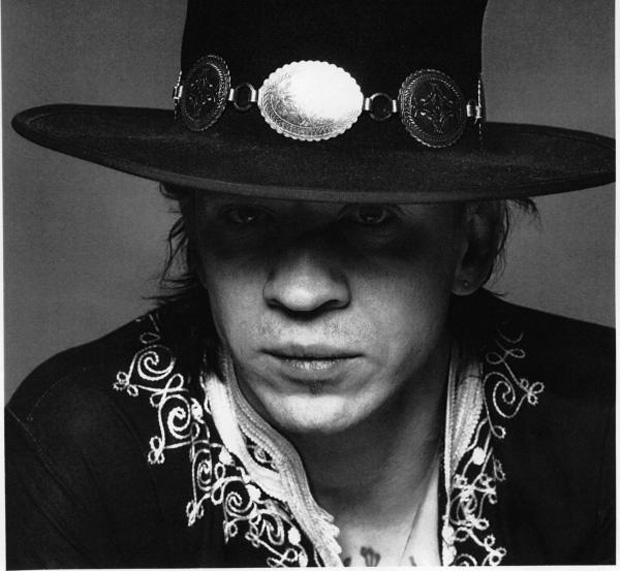Stevie Ray Vaughan Biography

Stevie Ray Vaughan was born in Dallas, Texas, on Oct. 3, 1954.
He began playing his older brother Jimmie’s guitars at the age of 7. With a prodigious knack for the instrument, Vaughan began performing in and around Dallas while Jimmie pursued his own musical career in Austin. Determined to follow in his brother’s footsteps, Stevie Ray dropped out of high school at 17 and moved to Austin with his band Blackbird.
Vaughan performed with several bands in the area, such as The Nightcrawlers, Paul Ray & the Cobras, and Triple Threat Revue – the band Vaughan formed with singer Lou Ann Barton that would eventually be streamlined into Double Trouble.
After a few years working the Austin music scene, Barton left Double Trouble, and Vaughan became the group’s frontman. During the early Eighties, the band secured a number of high profile gigs, playing a private party for the Rolling Stone’s in New York City, and the Montreux Jazz Festival in Switzerland.
Vaughan’s playing at Montreux caught the attention of Jackson Browne and David Bowie. Bowie asked Vaughan to play lead guitar on his upcoming album Let’s Dance. After completing the album, Vaughan was set to appear with Bowie on the Serious Moonlight Tour, but pulled out, choosing to focus on Double Trouble instead. The band had recorded a demo at Jackson Browne’s studio over Thanksgiving in 1982.
The demo found its way into the hands of noted producer and talent scout John H. Hammond. Hammond had discovered Bob Dylan and Bruce Springsteen, and convinced Epic Records to sign Stevie Ray Vaughan and Double Trouble. He served as executive producer of their debut album, Texas Flood.
Texas Flood sold 500,000 copies in its first week, and was later nominated for two Grammies. Vaughan and Double Trouble followed up their success with Couldn’t Stand the Weather, which peaked at 31 on the Billboard 200. With his star rising, Vaughan entered into a period of heavy drug and alcohol abuse. Coupled with a strained marriage, Vaughan’s reckless drug dependency hindered the recording of Double Trouble’s third album, Soul to Soul. Released in September of 1985, Soul to Soul failed to match the success of Couldn’t Stand the Weather.
Get The Pick Newsletter
All the latest guitar news, interviews, lessons, reviews, deals and more, direct to your inbox!
After finishing work on their first live compilation, Live Alive, Stevie Ray Vaughan and Double Trouble embarked on a tour of Europe. While in Germany, Vaughan began repeatedly vomiting blood. Taken to a hospital in London, he was told the cocaine he dissolved in his whiskey each morning had crystallized in his stomach and was lacerating his intestines. Doctors informed Vaughan if he continued the practice he would die in a month.
Double Trouble cancelled 12 dates in Europe as Vaughan entered rehab back in the states. After successful completion of treatment, he and the band returned to performing and collaborating with artists such as Stevie Wonder and Dick Dale.
When Epic was acquired by Sony Music Entertainment in 1987, a deal was worked out to renew Stevie Ray Vaughan and Double Trouble’s contract. In early 1989 they began recording In Step. The album was released in June. The single “Crossfire” reached number one on the Billboard Mainstream Rock Tracks, and In Step would go on to win the Grammy for Best Contemporary Blues Album.
In 1990, Vaughan entered Ardent Studios in Memphis to begin recording Family Style with Jimmie. After recording the album, Vaughan and Double Trouble began a summer tour with Joe Cocker. On August 26, the band appeared as guests at the Alpine Valley Music Theater in East Troy, Wisconsin on a bill with Eric Clapton, Buddy Guy, Robert Cray and Jimmie Vaughan.
Four helicopters were booked to fly the performers back to Chicago. Shortly before 1 a.m. Aug. 27, 1990, Vaughan, flying with members of Clapton’s crew, took off in dense fog. They struck a ski slope when the helicopter moments later. All aboard died instantly.
Vaughan’s aggressive, frenetic playing style set a new standard among blues guitarists. Modern guitarists such John Mayer, Mike McCready, and Kenny Wayne Shepherd, as well as contemporaries Steve Vai and Eric Johnson, have cited Vaughan as a prominent influence.
Vaughan was buried at Laurel Land Memorial Park in Dallas. The funeral was attended by more than 1,500 mourners, including Clapton, Guy, Bonnie Raitt, Dr. John, and Stevie Wonder. A memorial statue stands at Auditorium Shores on Lady Bird Lake in Austin. In 1991, the governor of Texas proclaimed Oct. 3 Stevie Ray Vaughan Day.
“Even the thought that Clapton might have seen a few seconds of my video feels surreal. But I’m truly honored”: Eric Clapton names Japanese neo-soul guitarist as one to watch
“You better be ready to prove it’s something you can do”: Giacomo Turra got exposed – but real guitar virtuosos are being wrongly accused of fakery, too










